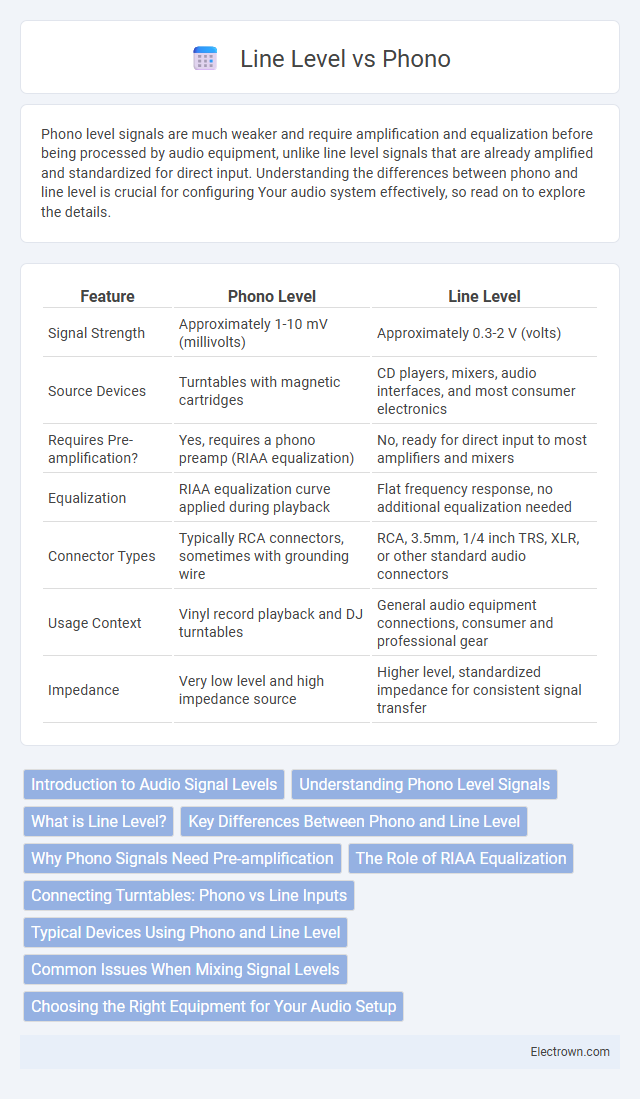Phono level signals are much weaker and require amplification and equalization before being processed by audio equipment, unlike line level signals that are already amplified and standardized for direct input. Understanding the differences between phono and line level is crucial for configuring Your audio system effectively, so read on to explore the details.
Table of Comparison
| Feature | Phono Level | Line Level |
|---|---|---|
| Signal Strength | Approximately 1-10 mV (millivolts) | Approximately 0.3-2 V (volts) |
| Source Devices | Turntables with magnetic cartridges | CD players, mixers, audio interfaces, and most consumer electronics |
| Requires Pre-amplification? | Yes, requires a phono preamp (RIAA equalization) | No, ready for direct input to most amplifiers and mixers |
| Equalization | RIAA equalization curve applied during playback | Flat frequency response, no additional equalization needed |
| Connector Types | Typically RCA connectors, sometimes with grounding wire | RCA, 3.5mm, 1/4 inch TRS, XLR, or other standard audio connectors |
| Usage Context | Vinyl record playback and DJ turntables | General audio equipment connections, consumer and professional gear |
| Impedance | Very low level and high impedance source | Higher level, standardized impedance for consistent signal transfer |
Introduction to Audio Signal Levels
Phono and line level represent standard audio signal strengths crucial for correctly connecting audio equipment. Phono level signals, typically generated by turntables, are much weaker and require amplification and equalization through a phono preamp to match line level strength. Understanding the distinction ensures Your audio setup maintains optimal sound quality and prevents distortion or noise issues.
Understanding Phono Level Signals
Phono level signals are significantly lower in voltage than line level signals, typically around 1 to 5 millivolts, requiring a dedicated phono preamplifier to boost the signal to line level. These signals carry the unique RIAA equalization curve, which compensates for the bass reduction and treble boost applied during vinyl record mastering, essential for accurate sound reproduction. Understanding phono level signals ensures you connect your turntable correctly to your audio system, preserving audio fidelity and preventing distortion.
What is Line Level?
Line level is the standard signal strength used to transmit audio between various audio equipment such as amplifiers, mixers, and playback devices. It typically ranges around 1.23 volts for professional gear (pro line level) and 0.316 volts for consumer devices (consumer line level). This consistent voltage ensures compatibility and optimal sound quality when connecting audio components without requiring additional amplification.
Key Differences Between Phono and Line Level
Phono and line level signals differ primarily in voltage and equalization requirements; phono level signals have much lower voltage (typically around 2-5 mV) and require RIAA equalization to balance bass and treble frequencies. Line level signals operate at higher voltages (approximately 1-2 volts) and do not need such equalization, making them compatible with most audio equipment inputs. Devices like turntables output phono level signals, while CD players and mixers output line level, necessitating a dedicated phono preamp when connecting turntables to standard line inputs.
Why Phono Signals Need Pre-amplification
Phono signals from turntables require pre-amplification because their voltage levels are significantly lower than typical line level signals, often in the millivolt range. This weak signal also includes a specific equalization curve (RIAA curve) that must be corrected by a phono preamp to ensure accurate sound reproduction. Your audio system benefits from this necessary boost and equalization, enabling seamless integration with standard line level inputs.
The Role of RIAA Equalization
Phono level signals require RIAA equalization to correct the frequency response of vinyl records, boosting bass frequencies and attenuating treble frequencies to match playback accurately. Line level signals are already standardized and do not need such equalization, making them compatible directly with most audio equipment. Your audio setup must consider this distinction to ensure proper sound quality when connecting turntables or other analog sources.
Connecting Turntables: Phono vs Line Inputs
When connecting turntables, understanding the difference between phono and line inputs is crucial for optimal sound quality. Phono inputs include a built-in preamplifier and RIAA equalization designed specifically for the low-level, equalized signal output from turntable cartridges, while line inputs expect a higher, flat signal typically from modern audio devices. To avoid distortion and ensure your turntable's output matches your audio system, connect it to the appropriate input type based on whether it has a built-in preamp or requires external phono preamplification.
Typical Devices Using Phono and Line Level
Phono level signals are typically used by turntables and record players, requiring a phono preamp for proper amplification and equalization. Line level signals are standard output levels for most audio devices like CD players, mixers, and audio interfaces, providing a stronger signal that does not require additional amplification. Understanding the distinction helps ensure compatibility between audio equipment and optimal sound quality.
Common Issues When Mixing Signal Levels
Common issues when mixing phono and line level signals include impedance mismatches and incorrect gain staging, which can lead to distortion or weak audio output. Phono signals require RIAA equalization and are significantly lower in voltage compared to line level signals, causing challenges in achieving balanced mix levels without noise interference. Proper matching using dedicated phono preamps and careful adjustment of input sensitivity prevents signal clipping and preserves audio fidelity in mixed setups.
Choosing the Right Equipment for Your Audio Setup
Selecting the appropriate equipment for your audio setup hinges on understanding the difference between phono and line level signals. Phono level signals require a dedicated phono preamp or amplifier input with RIAA equalization to boost and balance the frequency response, while line level signals can connect directly to standard inputs on mixers, receivers, or amplifiers without additional processing. Correctly matching your turntable, preamp, and receiver inputs ensures optimal sound quality and prevents signal distortion or damage to your audio components.
phono vs line level Infographic

 electrown.com
electrown.com